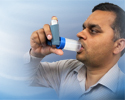COPD - control drugs
Chronic obstructive pulmonary disease - control drugs; Bronchodilators - COPD - control drugs; Beta agonist inhaler - COPD - control drugs; Anticholinergic inhaler - COPD - control drugs; Long-acting inhaler - COPD - control drugs; Corticosteroid inhaler - COPD - control drugs
Control medicines for chronic obstructive pulmonary disease (COPD) are medicines you take to control or prevent symptoms of COPD. You must use these medicines every day for them to work well.
These medicines are not used to treat flare-ups. Flare-ups are treated with quick-relief (rescue) medicines.
Depending on the medicine, control drugs help you breathe easier by:
- Relaxing the muscles in your airways
- Reducing any swelling in your airways
- Helping the lungs work better
You and your health care provider can make a plan for the control medicines that you should use. This plan will include when you should take them and how much you should take.
You may need to take these medicines for at least a month before you start to feel better. Take them even when you feel OK.
Ask your provider about the side effects of any medicines you are prescribed. Be sure you know which side effects are serious enough that you need to call your provider right away.
Follow instructions on how to use your medicines the right way.
Make sure you get your medicine refilled before you run out.
Anticholinergic Inhalers
Anticholinergic inhaled medicines include:
- Aclidinium (Tudorza Pressair)
- Glycopyrronium (Seebri Breezhaler)
- Tiotropium (Spiriva)
- Umeclidinium (Incruse Ellipta)
- Revefenacin (Yupelri) is a long acting nebulized medicine
Use your anticholinergic inhalers every day, even if you do not have symptoms.
Beta-agonist Inhalers
Beta-agonist inhaled medicines include:
- Arformoterol (Brovana used with a nebulizer)
- Salmeterol (Serevent)
- Olodaterol (Striverdi Respimat)
Do not use a spacer with beta-agonist inhalers.
Inhaled Corticosteroids
Inhaled corticosteroids include:
- Beclomethasone (Qvar)
- Ciclesonide (Alvesco)
- Mometasone (Asmanex)
- Budesonide (Pulmicort can be used in an inhaler or as a nebulized solution)
After you use these medicines, rinse your mouth with water, gargle, and spit.
Combination Inhaled Medicines
Combination medicines combine two or three drugs and are inhaled. They include (list is not complete):
- Albuterol and ipratropium (Combivent Respimat; Duoneb)
- Budesonide and formoterol (Symbicort)
- Fluticasone and salmeterol (Advair)
- Fluticasone and vilanterol (Breo Ellipta)
- Formoterol and mometasone (Dulera)
- Tiotropium and olodaterol (Stiolto Respimat)
- Umeclidinium and vilanterol (Anoro Ellipta)
- Glycopyrrolate and formoterol (Bevespi Aerosphere)
- Fluticasone and umeclidinium and vilanterol (Trelegy Ellipta)
- Budesonide and glycopyrrolate and formoterol (Breztri Aerosphere)
For all these medicines, some generic forms have just become or will become available in the near future, thus different names might also exist.
Phosphodiesterase Inhibitor
Roflumilast (Daliresp) is a tablet that is swallowed.
Antibiotics
Azithromycin is a tablet that is swallowed.
References
Global Initiative for Chronic Obstructive Lung Disease (GOLD) website. Global strategy for the diagnosis, management, and prevention of chronic obstructive pulmonary disease: 2024 report. goldcopd.org/2024-gold-report/. Accessed May 16, 2024.
Han MK, Lazarus SC. COPD: clinical diagnosis and management. In: Broaddus VC, Ernst JD, King TE, et al, eds. Murray and Nadel's Textbook of Respiratory Medicine. 6th ed. Philadelphia, PA: Elsevier; 2022:chap 64.
Reilly J. Chronic obstructive pulmonary disease. In: Goldman L, Cooney KA, eds. Goldman-Cecil Medicine. 27th ed. Philadelphia, PA: Elsevier; 2024:chap 76.
US Department of Veterans Affairs website. VA/DoD Clinical Practice Guideline for The Management Of Chronic Obstructive Pulmonary Disease, Version 3.0, April 2021. www.healthquality.va.gov/guidelines/CD/copd/VADoDCOPDCPGFinal508.pdf. Accessed May 16, 2024.
Waller DG. Asthma and chronic obstructive pulmonary disease. In: Waller DG, ed. Medical Pharmacology and Therapeutics. 6th ed. Philadelphia, PA: Elsevier; 2022:chap 12.
Review Date: 5/3/2024
Reviewed By: Allen J. Blaivas, DO, Division of Pulmonary, Critical Care, and Sleep Medicine, VA New Jersey Health Care System, Clinical Assistant Professor, Rutgers New Jersey Medical School, East Orange, NJ. Review provided by VeriMed Healthcare Network. Also reviewed by David C. Dugdale, MD, Medical Director, Brenda Conaway, Editorial Director, and the A.D.A.M. Editorial team.



